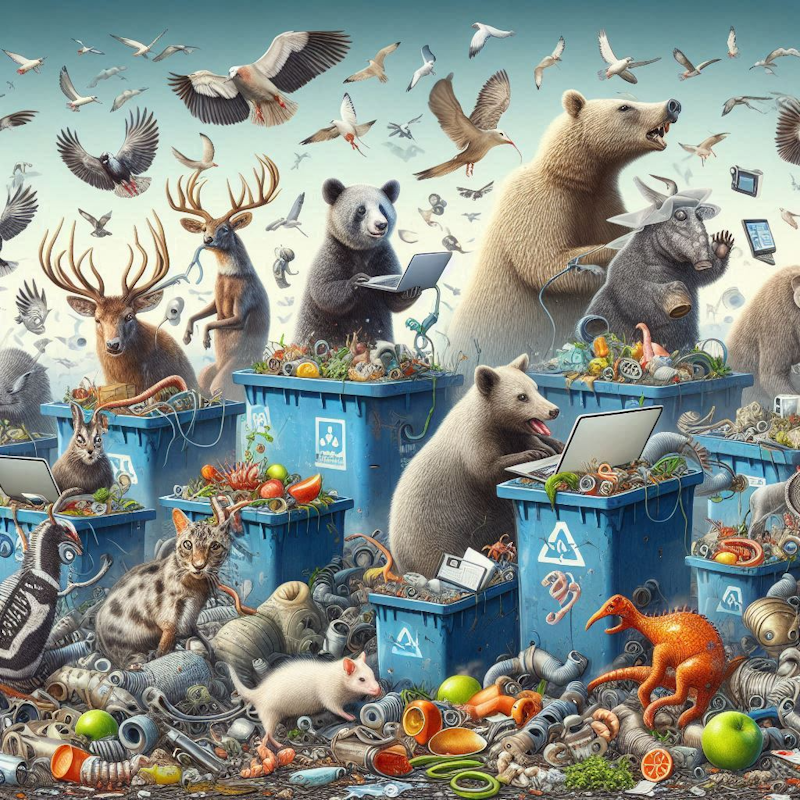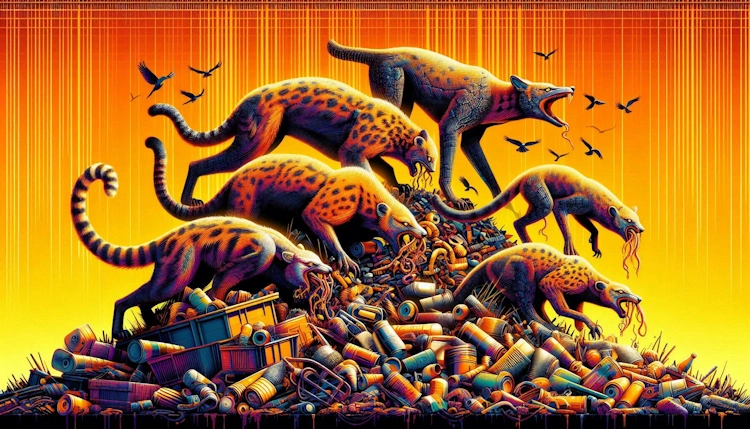Category: Science
November 13, 2024

Technology can be a useful friend in re-shaping waste management systems while the state deal with the growing challenges posed by waste production.
Innovative technologies are necessary to accelerate the movement toward a more sustainable planet with global waste generation estimated at 3.4 billion tons by 2050, up from 2.01 billion tons in 2016, the need to reduce environmental impact and develop more effective and sustainable waste management solutions is paramount.
Smart waste collection systems, waste pickers collection projects with AI solutions, projects on waste derived product recycling as well as new technology based solutions(i.e. pyrolysis) are essential components to maximize efficiency in controlling generated waste and handling it accordingly from source and onwards with the potential of transforming waste to resource or deriving energy.
It revolutionizes waste collection systems
Current waste collection systems are often suboptimal as they rely on fixed schedules and routes which do not allow for the different waste volumes produced in various places. This leads to either having the bins emptied when they are only half-full, or leaving a bin unattended until it filled up thus overflowing with trash.
A solution to this problem is provided by the so-called Smart waste collection systems, which use sensors and provide real-time information on a value of filled up with trash bin or garbage container. Garbage trucks are optimized in their collection routines to empty full trash cans with the help of these sensors communicating back to waste management systems. These involve the deployment of several Internet of Things (IoT) sensors in trash bins by companies such as Enevo and Bigbelly, which help to dramatically reduce pickups that bring down operational costs.
These systems can lead to the reduction in fuel consumption and carbon emissions with optimal waste collection routes, thus ensuring that you operate a more sustainable waste management process. They also help local governments and waste companies optimize resource allocation, so that garbage collection can be performed more effectively, avoiding overflowing bins that contribute to the overall littering of streets.
Recycling Innovations
Although recycling is essential for reducing waste in the landfill or incinerator, traditional recycling systems are usually inefficient and often “is a mess. Technology changes the way we recycle our waste. Technology is beginning to make a real difference in the world of recycling and one company leading the charge is our friends at Green Mark. The latter involves advanced sensors and sorting technologies that help to better separate materials from each other, ultimately reducing the contamination in the recycling stream.
Optical sorting technology is an advancement over that. Optical sensors can detect and sort different plastics, metals, and paper depending on their chemical composition or colour. This tech is able to sort those recycling at a much higher clip and with better accuracy, helping increase the efficiency of recycling plants everywhere. One example are optical sensors and near-infrared technology used by companies such as Tomra that enable the sorting of trash to be fully automated, while significantly enhancing recycling rates and lowering labor costs when it comes to manual sorting.
Robotics and AI are making big contributions where recycling is concerned as well. Robots even powered by AI like those made by AMP Robotics can rapidly spot and sort out recyclable materials on a conveyer belt. These robots get better over time, learning how to distinguish different types of waste and most efficiently deal with it. AI and robotics are also helping to enable smarter, faster sorting of recycling, as well as reducing contamination in recycling streams to make it a more efficient and cost-effective process.
Chemical recycling, which does not follow traditional mechanical methods of recycling, is another significant innovation. Chemical recycling is a process that breaks down plastics into their basic chemical building blocks, reclaiming them for the production of new products without loss in material quality. By developing processes to turn waste plastics into high quality feedstock for the manufacture of new plastic, companies such as Loop Industries are helping close the loop on recycling and reduce the demand for virgin plastic materials.
Waste-to-Energy Technologies
Waste-to-Energy (WTE) technologies One of the other great technological advances that have been made in waste management is with regard to WTE technologies. The energy conversion processes used can convert the waste materials into forms of energy that can directly replace products from fossil fuels: heat (or steam), electricity, or gas for use in CHP systems, which eliminate waste that otherwise would be landfilled and also provide a renewable source of energy.
Waste-to-energy is a well-established method of treating incineration waste, and modern WTE techniques are far more developed than in the past. Using the likes of gasification or pyrolysis, such processes entail heating waste at temperatures so high oxygen can’t be present, thus breaking it down into a synthetic gas or oil which can power energy systems. These technologies will typically produce fewer emissions than traditional incineration and are considered more sustainable options for waste management.
Meanwhile, anaerobic digestion is the form of waste-to-energy technology that is emerging. In turn, bacteria breakdown organic waste (food scraps and agricultural waste) in an oxygen-free environment which releases biogas that can even be used as fuel. This not only eliminates methane from landfills, but provides renewable energy. In Europe it is already highly employed, and in the U.S., cities and municipalities are opting for better organic waste treatment methods such as anaerobic digestion.
Data-Driven Waste Management
New technologies offer the ability to analyze data, and waste management is a perfect example of industries that big data and data analytics can completely change the way places or companies handle it. Through data we can know what waste generation, collection and disposal patterns are in the municipalities, thereby managing this destination more optimally and cheaper. Waste management companies using data-driven platforms like Rubicon can monitor waste collection routes, recycling rates and landfill usage in real time and run their operations more efficiently.
AI-driven predictive analytics additionally will offer insights into the waste production trends vis-à-vis to overall population growth, consumption patterns and economic activities thereby predicting future garbage generations. It helps cities and waste management companies be better prepared, so they can plan for the future and deal with high-growth regions more readily. This richer detail allows the city to use data-driven solutions by pinpointing areas of high waste generation and low recycling rates, to more efficiently target educational campaigns and policies aimed at reducing waste and increasing recycling participation.
Waste Management & Blockchain
Whilst typically associated with cryptocurrencies, the use of blockchain technology has been mooted for use in waste management solutions. By utilizing blockchain, waste management processes can be tracked more transparently and securely from the time when the waste is generated up until it reaches its last destination, reuse or recycling. It could cut down illegal dumping, bring accountability in waste management supply chain and make compliance easier for all.
One of them is the use of blockchain for social good, as implemented by companies like Plastic Bank (PlasticBank.net ), that uses a digital token in exchange for trash people collected over developing countries. This lays a framework that is transparent enough to track the success or failure of recycling plastic waste at the micro-level.
Technology is increasingly changing how waste management operates and it promises to provide solutions for many of the current challenges that the world needs to solve regarding waste reduction, recycling and resource management.
Technological improvements, ranging from intelligent waste collection systems and artificial intelligence (AI) driven recycling solutions to waste-to-energy processes and data-supported decision making for improved efficiency and sustainability of services, have led a transformation in the way that resources are being utilized now. With the ever increasing worldwide waste production, these will play a key role in minimizing the ecological footprint of waste and guaranteeing a more sustainable future for future generations with environmentally friendly solutions for waste management.
August 25, 2024

While it did not exist until the end of the 19th century, waste has colonized the living. Beyond the technical challenges it raises, it has become a field of investigation for the human sciences, which seek to shed light on the systems and myths at the source of its production.
It has become the familiar companions of our modern destinies. Abandoned on beaches, trapped in glaciers or concentrated in gigantic vortices in the oceans, waste has invaded all environments, colonizing even the living. Microscopic or cumbersome, in solid, liquid or gaseous state, it traces new globalized paths on the seas, saturates the air and the soil, and now invests space. Sometimes described as ultimate or eternal pollutants, it imposes itself on our plates, our drinking water, and even the tips of our hair.
The figures are staggering. Annual production of solid waste has exceeded 2 billion tons worldwide and is expected to reach 3.4 billion in 2050, warns the World Bank. The production of plastics has doubled in twenty years, estimates the Organisation for Economic Co-operation and Development (OECD), two-thirds of which are landfilled, incinerated or released into the environment.
While this omnipresence directly affects human health and that of ecosystems, it also leaves an indelible mark on human activities on Earth. Since the first piles left at the entrance to caves, witnesses to its sedentarisation, detritus tells the story of Homo sapiens, including construction waste.
Waste is everywhere
Microparticles of various plastics have been found in all the livers of people with cirrhosis. Conversely, they were undetectable in people without liver disease. Could they be the cause or consequence of the pathology? The authors of this study published in eBioMedicine are working on it, but note in any case that these substances can accumulate in human peripheral organs. Until now they had been found in blood, stools and the placenta.
They have landed in our trash, carried by advertising and its mirages of cleanliness and individuality. However, paradoxically, the more beautiful and white they are, the more polluting they are. These are the disposable objects, cups, handkerchiefs, telephones, deodorant sticks, whose history philosophers trace in her consumerism through its objects.
Indispensable telephones
Without being immediately disposable, but at least as polluting, smartphones have been the subject of a rapid and massive diffusion, at a unique point in the history of technology. Thanks to the systemic network effect, the object becomes in itself a means of integration, or exclusion.
In some countries, such as China, you need a smartphone to take public transportation. An expert in planned obsolescence warns the reader against the many ways to avoid overconsumption. Do we really prevent overconsumption, for example, by marketing a vegetarian steak? Do we really help the environment by replacing polystyrene with cardboard, as McDonald’s did in the 1990s? Why not reduce the use of plastic altogether rather than relying on recycling it? Should laws on planned obsolescence, such as the one in force in Virginia, be more widely applied?
How the state of Virginia is developing policies to reduce waste
The state of Virginia is actively developing and implementing policies aimed at reducing waste and promoting environmental sustainability. One of the central efforts is the Virginia Environmental Excellence Program (VEEP), which encourages businesses and local governments to adopt proactive environmental management practices, including waste reduction and recycling initiatives. Participants in the VEEP like Same Day Dumpster Rental Norfolk are recognized for their commitment to sustainability and can benefit from regulatory flexibility and other incentives.
The state of Virginia has also been working on enhancing its solid waste management regulations. The Department of Environmental Quality (DEQ) oversees these regulations, focusing on comprehensive waste management strategies that include recycling, composting and waste-to-energy programs. The DEQ provides guidance and support to local governments and businesses to improve their waste reduction efforts and compliance with state and federal laws.
Another significant policy initiative is the Virginia Plastic Waste Prevention Advisory Council, established to address the growing issue of plastic waste. The council is tasked with developing strategies to reduce plastic pollution, promoting the use of alternative materials and increasing public awareness about the environmental impacts of plastic waste.
Virginia is also investing in public education campaigns to raise awareness about the importance of waste reduction and recycling. These campaigns aim to inform residents about best practices for reducing household waste, proper recycling techniques, and the benefits of composting organic materials.
Through these combined efforts, the state of Virginia is making strides in reducing waste generation, enhancing recycling rates, and fostering a culture of sustainability among its residents and businesses.
December 19, 2015
 Applications directly using semantics are not lacking. We can mention research on automatic summarization or machine translation. Semantics is also involved in robotics, in particular the reasoning in natural languages, the man-machine dialogue. Semantics is, in the language sciences, as opposed to syntax.
Applications directly using semantics are not lacking. We can mention research on automatic summarization or machine translation. Semantics is also involved in robotics, in particular the reasoning in natural languages, the man-machine dialogue. Semantics is, in the language sciences, as opposed to syntax.
The syntax is concerned with formal rules, whereas semantics concerns itself with meaning. The goal of the Semantic Web is to allow machines to exchange information using the meaning of words as in natural languages. This ambitious goal requires a lot of work on languages, systems and ontologies. As part of this objective, Topic Maps need to hold an important place.
For example, traditional search engines operate syntactically: a query on the keyword “sun” will fetch in a database pages containing the string [sun] regardless of the meaning of this word which depends of course on context. We found both the Auberge du Soleil, the Théâtre du Soleil, a catalog of sunglasses … plus pages about the Sun Star. In a Topic Map, we would create a Topic Sun, which will be defined according to the context. Ties with the Topic, via associations and occurrences are semantic links.
Language and symbolic capacity are at the heart of research in cognitive science (brain science). Scientists have discovered the biological basis of conscious experience. In addition to the exceptional concentration of nerve cells in the human brain, there is a vast network of connections between different cortical areas, which have various functions.
“The areas that coordinate language must be connected to all other sensory modalities, because we can recognize and identify an object by touch as well as vision, hearing or smell. All this information must find its way to the generator of the word.
However, intermodal connections between different cortical areas are far fewer in animals whose sensory systems remain more isolated, researchers recently found out. If the animal detects a stimulus by the visual system, it is not certain that it knows to generalize it in another modality, such as touch, for example.
Animals generalize much less than humans because they have less intermodal connections. The capacity for abstraction, generalization, is more advanced in humans (for better or for worse) and the intermodal capacity for abstraction is made possible by combining concept-word (or signified-signifier).
The symbolic capacity, is the fact that the symbols “milk”, “juice” … return home not only to a physical reality but also other symbols such as “liquid”, “fruit extract” etc.. It is this ability that allows us to invent imaginary animals, imaginary worlds from properties that have symbolic animals and real situations, or to imagine a life after death …
One wonders what is the semantics of programming. In fact, we find the term in mathematics since the 30s. Mathematical logic is a very precise language derived from natural language and designed to avoid ambiguity. Mathematical logic includes a formal syntax that says for example that the following sentence is correct: for any natural number x, there is a successor of the number x.
But there is also a formal semantics giving meaning to the symbols invariable and accurate, in terms of values or truths of set theory. Theorists have extended these computer methods to the analysis of programming languages. We thus find the term semantics in linguistics, mathematical logic and computer science.
For their part, linguists working in formal semantics extend these methods to the analysis of conjunctions (and, hence, so …), determinants (all, some, each, several …), the negation of verb tenses etc. Any linguistic semantics, even more intuitive, can be reformulated logically.
It is obviously possible to make the semantics intuitively. But reading semantics, we always ask: what is the link between semantics and intuitive logic? The challenge is to make the link between the two. (ie a bit of logic and set theory), taking into account the fact that your knowledge of logic are limited.



 Applications directly using semantics are not lacking. We can mention research on automatic summarization or machine translation. Semantics is also involved in robotics, in particular the reasoning in natural languages, the man-machine dialogue. Semantics is, in the language sciences, as opposed to syntax.
Applications directly using semantics are not lacking. We can mention research on automatic summarization or machine translation. Semantics is also involved in robotics, in particular the reasoning in natural languages, the man-machine dialogue. Semantics is, in the language sciences, as opposed to syntax.